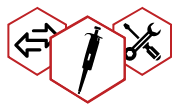Pipette Frequently Asked Questions
All Gilson pipettes carry a serial number which identifies the pipette and the date of manufacture (see example below).
example of a serial number A10369H
The first letter represents the year of manufacture.
The number is the individual production number.
The last letter corresponds to the month of manufacture.
Letter
- A
- B
- C
- D
- E
- G
- H
- J
- K
- L
- M
- N
- P
- Q
- R
- S
- T
- U
- W
- X
- Y
- Z
Year
- 1984
- 1985
- 1986
- 1987
- 1988
- 1989
- 1990
- 1991
- 1992
- 1993
- 1994
- 1995
- 1996
- 1997
- 1998
- 1999
- 2000
- 2001
- 2002
- 2003
- 2004
- 2005
Letter
- A
- B
- C
- D
- E
- G
- H
- J
- K
- L
- M
- N
Month
- January
- February
- March
- April
- May
- June
- July
- August
- September
- October
- November
- December
1. Tip holder is scratched or damaged
2. Use of non-Gilson tips
3. Use of non-Gilson seals
4. Vapour pressure from organic solvents
Click here to view the "2 Minute Inspection" procedure
What are the main causes of leaks in non-Gilson pipettes?
Tip holder / shaft is scratched or damaged Pipette may require grease* as a preventative measure (see the manufacturers' user's guide)
Use of non-genuine spare parts
Use of generic / universal tip
Vapour pressure from organic solvents
*Please do not grease your Gilson Pipetman and Neo Single Channel pipettes
When an organic solvent is used with an air-displacement pipette, leaks may occur. These leaks are caused by the difference between the vapor pressure of the solvent and pressure of the air cushion between the piston and the sample.
Solution
1. Use a positive-displacement pipette because it has no air cushion.
2. If you are using an air-displacement pipette, saturate the air cushion of your pipette with solvent vapor by aspirating and distributing solvent repeatedly. The leak will stop when pressure equilibrium is reached.
After contact with corrosive liquids, a piston should be cleaned with alcohol and a soft tissue. Take care to avoid shocks or scratches.
Send your pipettes in for repair to:
Mandel Scientific Company Inc.
2 Admiral Place, Guelph, Ontario, N1G 4N4
Remember to enclose the Pipette Service Form with your pipettes when shipping.
Please note: To ensure the safety of all personnel, pipettes MUST be free of biological and radioactive hazards.
To prevent corrosion, contamination or breakage. Always store your pipettes vertically to prevent liquids from running inside the shaft of the pipette. Do not leave your pipette lying on the workbench where it can come into contact with chemicals or fall off and break.
Use a Pipetman pipette with Diamond sterilized filter tips when faced with at least two of the following situations at the same time:
- working in sterile conditions
- pipetting aqueous samples
- avoiding cross-contamination
Use a Microman pipette with sterilized capillaries and pistons when faced with at least two of the following situations at the same time:
- working in sterile conditions
- pipetting viscous samples
- avoiding cross-contamination
For more information on Pipette Clinics and Seminars please contact a Manual Liquid Handling Service Representative at:
Mandel Scientific Company Inc.
email:service@mandel.ca
Toll Free: 800-265-8356
Only genuine Gilson replacement parts should be used for your Gilson pipettes. Mandel is the exclusive Canadian agent for Gilson S.A.
Specifications are established by the manufacturer. They guarantee, in terms of accuracy and precision, the performance of all pipettes of a given brand and a given model at a certain volume setting.
Accuracy
- is the ability of a measuring instrument to give responses close to a true value.
Precision
- is the ability of an instrument to provide closely similar responses (measurements). Precision is also referred to as repeatability and/or reproducibility.
Always use Gilson calibrated pipette tips for Gilson pipettes.
Push upward on the tip-ejector to make sure it is positioned properly.
Clean the tip holder with alcohol. If it is worn or has been chemically attacked, order a new part.
If you apply grease to the internal parts of a pipette, it will need to be removed with a solvent for cleaning during servicing and could alter the calibration of the pipette.
Other service agencies who do not use original Gilson spare parts or who wish to reduce costs, rather than replacing parts, may use grease to obtain an air-tight seal. Grease may harbour contaminants within the pipette, introduced through aerosols or when pipetting volatile liquids. These are retained in the grease and may advance corrosion of internal pipette parts such as pistons. Don't let anyone grease your Pipetman!
